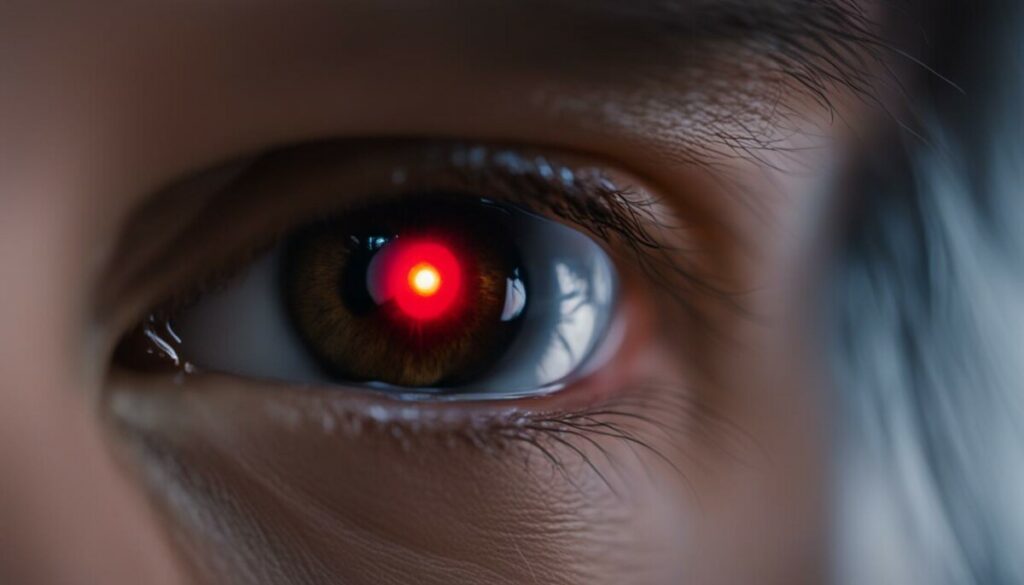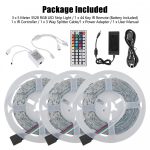Last Updated on 5 months by Francis
In recent years, LED lights have become increasingly popular for their energy efficiency and long-lasting durability. However, concerns have been raised about the potential risks associated with infrared radiation emitted by these lights. It is important to understand the safety considerations when it comes to using infrared LEDs in order to protect ourselves and our health.
Contents
Key Takeaways:
- Excessive exposure to infrared radiation can lead to eye damage, skin burns, and discomfort.
- To minimize risks, choose LEDs with low infrared emission and maintain a safe distance from the lights.
- Limit your exposure time to infrared LEDs and seek professional advice if needed.
- Infrared LED lights offer numerous benefits, including energy efficiency and durability.
- By using infrared LEDs responsibly, the advantages outweigh the potential hazards, allowing for a safe and sustainable lighting solution.
Understanding Infrared Radiation

Infrared radiation is a form of electromagnetic radiation that is invisible to the human eye but can be felt as heat. LED lights emit a small amount of infrared radiation, which has raised concerns about potential health effects. However, studies suggest that the levels emitted by LEDs are within safe limits defined by international standards.
Experts have conducted extensive research to evaluate the potential risks associated with infrared radiation from LED lights. The findings indicate that the amount of infrared radiation emitted by LEDs is minimal and does not pose a significant health risk. However, it is important to note that prolonged and excessive exposure to any source of radiation, including infrared radiation, should be avoided or minimized to ensure optimal safety.
It is also worth mentioning that LED lights emit visible light as well as a small amount of heat. While this heat can be dissipated using proper thermal management techniques, it is generally not a cause for concern. LED lights are designed to operate within a safe temperature range and incorporating adequate heat sinking and ventilation in lighting fixtures can further enhance their performance and longevity.
It is important to note that the potential health effects of infrared radiation from LED lights are minimal. By following safety guidelines and practicing responsible usage, the benefits of LED lighting, including energy efficiency and durability, outweigh any potential hazards.
Proper lighting levels and regular breaks from prolonged screen use are essential for minimizing eye strain and discomfort, regardless of the lighting type used. It is recommended to maintain a safe distance from LED lights, especially high-intensity ones, and limit exposure time. Additionally, choosing LED lights with low infrared emission can further mitigate any concerns regarding potential health risks.
| LED Lighting Type | Visible Light Emission | Infrared Radiation Emission |
|---|---|---|
| Traditional Incandescent Bulb | High | Low |
| Fluorescent Tube | Medium | Low |
| LED Light | High | Low |
In conclusion, while concerns have been raised about infrared radiation from LED lights, the overall safety of these lighting solutions remains within acceptable limits. By understanding the nature of infrared radiation, practicing responsible usage, and choosing LEDs with low infrared emission, individuals can enjoy the benefits of LED lighting while minimizing any potential health risks.
Advantages of LED Lights
LED lights offer numerous advantages that make them a popular choice for lighting solutions. One of the key benefits is their energy efficiency. LED lights consume significantly less energy compared to traditional bulbs, resulting in reduced electricity bills and lower carbon footprints. This not only helps save money but also contributes to a greener environment.
Additionally, LED lights have a long lifespan, lasting much longer than traditional bulbs. This reduces the frequency of replacements, saving both time and money in the long run. LED lights are also environmentally friendly as they are free from harmful substances like mercury, making them a safer choice for both indoor and outdoor lighting.
“LED lights are a game-changer in terms of energy efficiency. Not only do they help save on electricity costs, but they also have a positive impact on the environment by reducing greenhouse gas emissions.”
LED lights are versatile and can be used in various settings. They come in a variety of shapes and sizes, making them suitable for different lighting designs and applications. From residential homes to commercial spaces, LED lights can provide flexible and customizable lighting solutions.
| Advantages of LED Lights |
|---|
| Energy efficient |
| Long lifespan |
| Environmentally friendly |
| Versatile |
Managing Infrared LED Safety
In order to ensure a safe experience with infrared LED lights, it is essential to follow certain precautions and safety guidelines. By taking the appropriate measures, you can minimize any potential risks associated with infrared radiation and enjoy the benefits of LED lighting.
Precautions for Using Infrared LEDs
When using infrared LED lights, consider the following precautions:
- Choose LEDs with low infrared emission: Opt for LED lights that emit a minimal amount of infrared radiation. This can help reduce the risk of excessive exposure.
- Maintain a safe distance: Keep a distance between yourself and the LED lights to minimize direct exposure to infrared radiation.
- Use diffusers or covers: Applying diffusers or covers on LED lights can help distribute the light more evenly and reduce concentrated exposure.
- Limit exposure time: Avoid prolonged exposure to infrared LED lights. Take regular breaks to give your eyes and skin a rest.
- Seek professional advice: If you have any concerns about the safety of infrared LED lights, consult with a professional who can provide guidance based on your specific situation.
By following these precautions and safety guidelines, you can confidently enjoy the benefits of infrared LED lighting while minimizing any potential risks.
| Precaution | Description |
|---|---|
| Choose LEDs with low infrared emission | Opt for LED lights that emit a minimal amount of infrared radiation to reduce the risk of excessive exposure. |
| Maintain a safe distance | Keep a distance between yourself and the LED lights to minimize direct exposure to infrared radiation. |
| Use diffusers or covers | Applying diffusers or covers on LED lights can help distribute the light more evenly and reduce concentrated exposure. |
| Limit exposure time | Avoid prolonged exposure to infrared LED lights. Take regular breaks to give your eyes and skin a rest. |
| Seek professional advice | If you have any concerns about the safety of infrared LED lights, consult with a professional who can provide guidance based on your specific situation. |
By following these precautions and safety guidelines, you can confidently enjoy the benefits of infrared LED lighting while minimizing any potential risks.
Health Concerns or Hype?

As with any new technology, concerns about potential health effects arise. LED lights have been the subject of scrutiny, particularly regarding eye strain and discomfort. However, it’s important to note that the levels of infrared radiation emitted by LED lights are considered to be within safe limits defined by international standards. So, are these health concerns real or just hype?
“The levels of infrared radiation emitted by LED lights are considered to be within safe limits defined by international standards.”
Studies suggest that proper lighting levels and regular breaks are essential for minimizing eye strain, regardless of the lighting type used. This means that regardless of whether you are using LED lights or traditional bulbs, it’s important to take breaks from screens and ensure adequate lighting conditions to protect your eyes.
“Regardless of whether you are using LED lights or traditional bulbs, it’s important to take breaks from screens and ensure adequate lighting conditions to protect your eyes.”
LED lights do emit a small amount of heat, but research indicates that the amount generated is minimal and not a significant health risk. Therefore, while there may be some concerns surrounding LED lights, it is crucial to understand that when used responsibly and within recommended guidelines, the benefits of LED lighting outweigh the potential hazards. LED lights provide energy efficiency, durability, and versatility, making them a safe and sustainable lighting solution for a variety of applications.
In conclusion, the health concerns surrounding LED lights are mostly hype rather than grounded in substantial scientific evidence. By choosing LEDs with low infrared emission, managing exposure time, and maintaining proper lighting levels, any potential risks can be minimized. LED technology continues to evolve and offer numerous advantages, making it a viable and safe lighting solution for the future.
Exploring the Advantages of Infrared LED Lighting

When it comes to lighting solutions, infrared LED lighting offers a wide range of advantages over traditional systems. With its energy efficiency and durability, it has become an increasingly popular choice for various applications. Let’s take a closer look at some of the key benefits of infrared LED lighting.
Energy Efficiency
Infrared LED lights are highly energy-efficient, consuming less power compared to traditional lighting options. This not only results in cost savings but also helps reduce overall energy consumption. By using infrared LED lighting, businesses and homeowners can contribute to a greener environment while enjoying the benefits of long-lasting and bright illumination.
Durability and Long Lifespan
Infrared LED lights are known for their durability. They are built to withstand harsh environments and can handle fluctuations in temperature and humidity. Additionally, infrared LED lights have a long lifespan, reducing the need for frequent replacements and maintenance. This makes them a cost-effective option in the long run.
| Advantages of Infrared LED Lighting | Traditional Lighting |
|---|---|
| Energy Efficiency | Higher energy consumption |
| Durability | Less resistant to harsh conditions |
| Lifespan | Shorter lifespan, frequent replacements |
Flexibility and Versatility
Infrared LED lighting offers flexibility in terms of design and application. Its compact size and ability to emit light in different directions make it suitable for various lighting configurations. Whether it’s for residential, commercial, or industrial use, infrared LED lights can be customized to meet specific lighting needs.
With their energy efficiency, durability, and versatility, infrared LED lights are a smart choice for those seeking sustainable and reliable lighting solutions. Whether you’re looking to illuminate your home, office, or outdoor space, infrared LED lighting provides numerous advantages that can enhance your lighting experience.
The Future of Infrared LED Lighting
As technology continues to advance, the future of infrared LED lighting looks bright. LED lighting has already gained significant popularity due to its numerous advantages, such as energy efficiency and long lifespan. Infrared LED lighting, specifically, is expected to play a pivotal role in the lighting industry due to its unique properties and applications.
The growth of the LED lighting market further emphasizes the promising future of infrared LED lighting. LED technology is projected to reduce global electricity demand significantly, making it a sustainable choice for lighting solutions. With increased awareness about energy conservation and environmental impact, more and more individuals and businesses are opting for LED lighting, including infrared LEDs.
One of the key advantages of infrared LED lighting is its versatility. It can be used in various applications, from surveillance systems to medical treatments. Infrared LEDs are also known for their energy efficiency, consuming less energy compared to traditional lighting options. This not only leads to cost savings but also reduces the carbon footprint, contributing to a greener environment.
In conclusion, the future of infrared LED lighting holds immense potential. With advancements in technology and growing demand for sustainable lighting solutions, infrared LEDs are set to carve a significant niche in the lighting industry. Whether it’s for residential, commercial, or industrial use, the benefits of infrared LED lighting make it a compelling choice for the future.
| Advantages of Infrared LED Lighting | Future Potential |
|---|---|
| Energy efficiency | Prominent role in the lighting industry |
| Versatility in applications | Projected growth of the LED lighting market |
| Reduced carbon footprint | Sustainable choice for lighting solutions |
“The future belongs to those who believe in the beauty of their dreams.” – Eleanor Roosevelt
Illuminating with Infrared LED Technology

Infrared LED technology offers a range of eco-friendly features that contribute to its growing popularity. One of the key advantages is its energy efficiency, which allows for significant cost savings and reduced carbon footprint. Infrared LEDs consume less energy compared to traditional lighting options, making them an environmentally conscious choice.
The long lifespan of infrared LED bulbs is another eco-friendly aspect. With a longer operational life, these bulbs require fewer replacements, leading to less waste generation. This not only reduces the impact on the environment but also lowers maintenance costs for users.
“Infrared LED technology provides energy-efficient and environmentally friendly lighting solutions.”
Furthermore, infrared LEDs emit zero UV emissions, making them ideal for use in sensitive environments, such as museums or galleries, where UV radiation could harm delicate artifacts or artwork. By choosing infrared LED technology, consumers can enjoy the benefits of energy efficiency while contributing to a greener and more sustainable future.
The Role of Thermal Management in LED Safety
Proper thermal management is crucial for ensuring the safety and optimal performance of LED lights. LEDs generate heat during operation, and if not effectively managed, it can impact their lifespan and performance. To optimize heat transport and maintain a safe operating temperature, several strategies can be employed.
Heat Conduction and Material Selection
Efficient heat conduction is essential to prevent excessive heat buildup around LEDs. Materials with high thermal conductivity, such as copper or aluminum, can effectively conduct heat away from the LED. These materials should be used in the design and construction of heat sinks or other components that come into direct contact with the LED.
Minimizing Thermal Resistance
To maximize heat dissipation from LEDs, it’s important to minimize thermal resistance. This can be achieved by reducing the number of interfaces between the LED and the heat sink or other thermal management components. Additionally, any gaps or spaces should be filled with thermally conductive materials to ensure efficient heat transfer.
Estimating Junction Temperature
Calculating the junction temperature of LEDs can provide valuable insights into their thermal performance. By considering factors such as power dissipation, thermal resistance, and ambient temperature, it becomes possible to estimate the temperature at the junction of the LED. This information helps ensure that LEDs operate within safe temperature limits.
| Thermal Management Strategy | Benefits |
|---|---|
| Effective Heat Conduction | – Prevents excessive heat buildup – Maximizes heat dissipation |
| Minimizing Thermal Resistance | – Optimizes heat transfer – Ensures efficient cooling |
| Estimating Junction Temperature | – Provides insights into thermal performance – Helps maintain safe operating temperatures |
By implementing proper thermal management techniques, the safety and performance of LED lights can be significantly improved. Effective heat conduction, minimizing thermal resistance, and estimating junction temperature are essential aspects of LED thermal management. By optimizing heat transport, LED lights can operate at safe temperatures, ensuring their longevity and reliable performance.
Fixture Performance and Considerations
When it comes to LED lighting systems, the performance of the fixtures plays a crucial role in their overall effectiveness. The thermal performance of these fixtures is particularly important in ensuring optimal performance and longevity of the LEDs. Proper heat sinking and efficient thermal management are key factors in maintaining safe temperatures and maximizing the lifespan of the LEDs.
Sealed fixtures, while they may provide protection against dust and moisture, can hinder the efficient transfer of heat. This can lead to long-term issues such as overheating and reduced performance. It is important to choose fixtures that allow for effective heat dissipation, allowing the LEDs to operate within a safe temperature range.
Additionally, the design and material of the fixture itself can impact thermal performance. Good thermal conductivity is essential, as it enables heat to be conducted away from the LEDs quickly and efficiently. Minimizing the number of interfaces and using thermally conductive materials in any gaps can help optimize heat transfer and prevent overheating.
Table: Factors Affecting Thermal Performance of LED Fixtures
| Factors | Impact on Thermal Performance |
|---|---|
| Fixture design | Efficient heat dissipation, reducing the risk of overheating |
| Material selection | Thermal conductivity, ensuring effective heat transfer |
| Heat sinking | Provides a pathway for heat to escape, preventing heat buildup |
| Sealing | Affects heat dissipation and can hinder thermal performance |
By carefully considering these factors and selecting fixtures that prioritize thermal performance, you can ensure that your LED lighting system operates at its best. This not only maximizes the lifespan and efficiency of the LEDs but also minimizes the risk of performance issues due to overheating. When in doubt, consulting with a professional can provide valuable guidance in selecting fixtures that meet your specific requirements.
Conclusion
After examining the potential risks and benefits of infrared LEDs, it is clear that they can be used safely by taking appropriate precautions. While some may question if infrared LEDs are dangerous, studies indicate that the levels of infrared radiation emitted by these lights are within safe limits defined by international standards.
To minimize any potential risks, it is important to follow safety guidelines. Choose LEDs with low infrared emission, as they emit less radiation. Additionally, maintaining a safe distance from the lights and limiting exposure time can help reduce direct exposure to infrared radiation.
By using infrared LEDs responsibly and implementing these risk-reducing measures, it is possible to enjoy the advantages they offer. These advantages include energy efficiency, durability, and versatility. Infrared LED technology is a safe and sustainable lighting solution when used in a manner that minimizes potential hazards.
FAQ
Are infrared LEDs dangerous?
No, infrared LEDs emit a small amount of infrared radiation that is within safe limits. By following safety guidelines, the potential risks can be minimized.
What is infrared radiation?
Infrared radiation is a form of electromagnetic radiation that is not visible to the human eye but can be felt as heat.
What are the benefits of LED lights?
LED lights are energy-efficient, have a long lifespan, are ecologically friendly, and can be used in various settings.
How can I manage infrared LED safety?
To manage infrared LED safety, choose LEDs with low infrared emission, maintain a safe distance, limit exposure time, and seek professional advice if needed.
Are there any health concerns with LED lights?
Some concerns include eye strain and discomfort, but proper lighting levels and regular breaks can help minimize these issues.
What are the advantages of infrared LED lighting?
Infrared LED lighting offers energy efficiency, durability, and versatility in various applications.
What does the future hold for infrared LED lighting?
The LED lighting market is projected to grow, and with advancements in energy efficiency, infrared LED lighting is set to play a significant role.
What are the eco-friendly features of infrared LED technology?
Infrared LED technology offers energy efficiency, reduced carbon footprint, and zero UV emissions.
Why is thermal management important for LED safety?
Proper thermal management ensures that LEDs operate at safe temperatures, maximizing their lifespan and performance.
What should I consider regarding fixture performance?
Good heat sinking and thermal management are crucial for efficient thermal transfer, optimizing the performance of LED systems.
Are infrared LED lights safe to use?
Yes, by following safety guidelines and using infrared LEDs responsibly, they can provide a safe and sustainable lighting solution.



.jpg)
.jpg)
.jpg)


